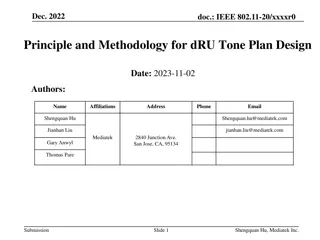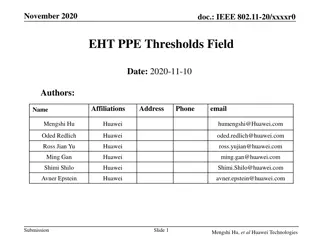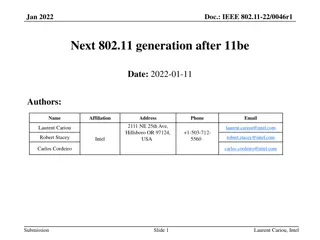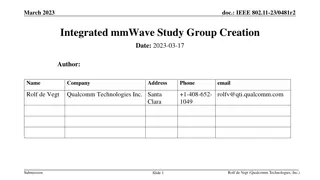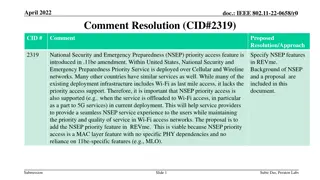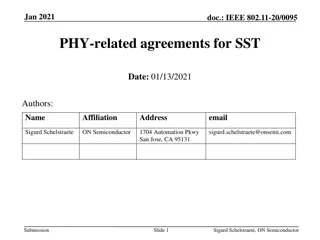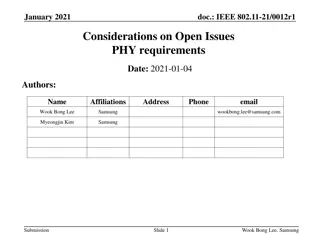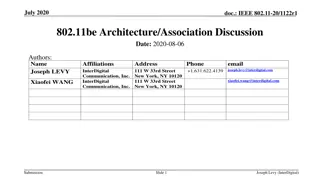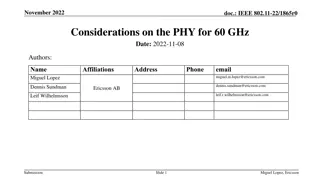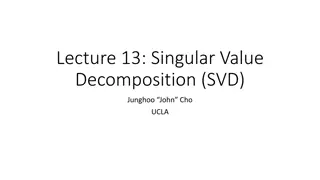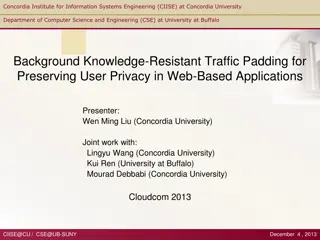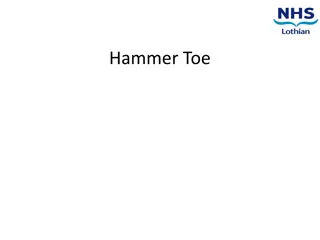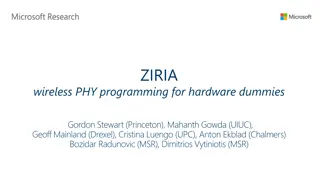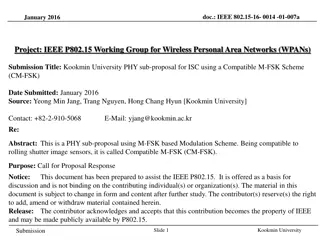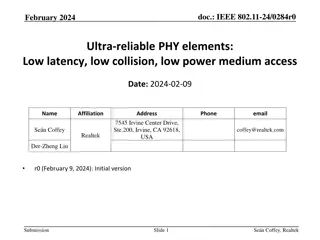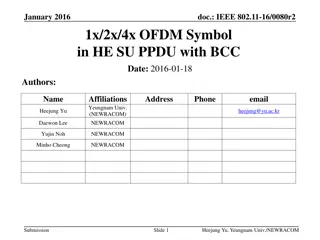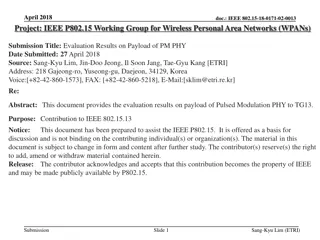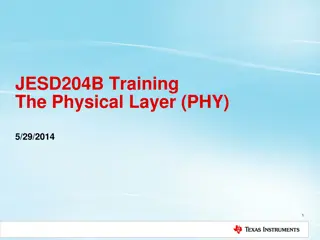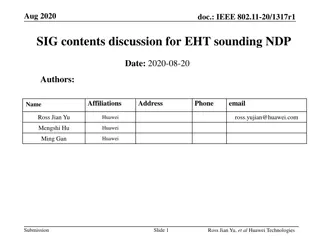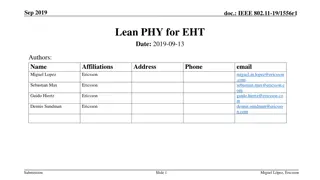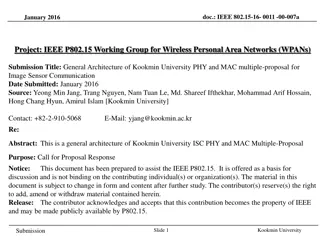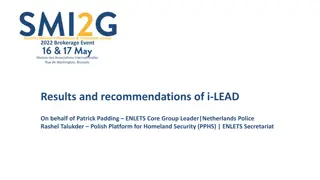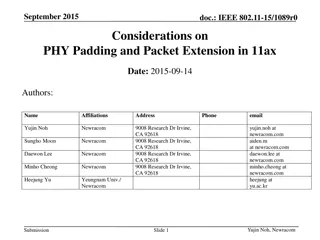Principle and Methodology for dRU Tone Plan Design in IEEE 802.11-20
Introduction of Distributed Tone RU (dRU) as a potential UHR PHY feature to address PSD limitations for 6GHz LPI and enhance Rate vs. Range performance. Emphasis on dRU tone plan design criteria, methodologies, and performance simulations. Detailed examination of design principles, methods, consider
4 views • 23 slides
Revisiting LDPC Rate Matching in IEEE 802.11 for Improved Performance
The document discusses revisiting LDPC rate matching in IEEE 802.11, focusing on issues such as performance loss compared to previous standards, power consumption in LDPC decoding/encoding, and over puncturing. It covers preliminary concepts, packet size distribution in various devices like laptops
2 views • 17 slides
Introduction to IEEE 802.11-20 EHT PPE Thresholds Field
IEEE 802.11-20 standard defines the Nominal Packet Padding values and Pre-FEC Padding Factors for PE fields in 11ax. The selection of Nominal Packet Padding values is crucial and can be determined using specific methods, including PPE Thresholds Present subfield. The PPE Thresholds field contains in
0 views • 14 slides
Evolution of Wi-Fi and Cellular Technologies for Next Generation
The document discusses the initiation of a new study group for the next generation of Wi-Fi following IEEE 802.11be, emphasizing objectives like deterministic operation, increased throughput, and capacity. It outlines a timeline for the launch of new mainstream PHY/MAC generations every four years.
6 views • 12 slides
Exploring Machine Learning Applications in Enhancing 802.11 Performance
This document delves into recent research on utilizing machine learning (ML) to enhance 802.11 performance, focusing on emerging use cases and the increased interest in ML applications in the field since 2019. It outlines the ML areas frequently used, such as supervised learning (SL) and reinforceme
1 views • 23 slides
Discussion on IEEE 802.11be MLD Architecture Alignment
IEEE 802.11 TGbe is exploring MLDs within the 802 architecture, focusing on aligning MLD operations with existing 802.11 features for enhanced compatibility. The MLD architecture aims to facilitate the flow of data between MAC SAPs and PHY SAPs, extending the current framework for APs and non-AP STA
1 views • 23 slides
IEEE 802.11 Integrated mmWave Study Group Creation Update
The March 2023 document discusses the formation of the IEEE 802.11 Integrated mmWave Study Group to focus on specifying carrier frequency operation between 42.5 and 71 GHz. The motion for Study Group creation received a mixed response during a meeting. The group aims to develop a new MAC/PHY standar
0 views • 4 slides
Proposal to Add National Security and Emergency Preparedness Priority Access Feature in IEEE 802.11be Amendment
The document proposes integrating the National Security and Emergency Preparedness (NSEP) priority access feature into the IEEE 802.11be standard to ensure seamless NSEP service experience, particularly in Wi-Fi networks used as last-mile access. The NSEP priority feature at the MAC layer is indepen
0 views • 12 slides
Understanding IEEE 802.11-22/2083r1 Wake-Up Radio (WUR) and MC-OOK Signals
The document explores the IEEE 802.11-22/2083r1 specifications regarding Wake-Up Radio (WUR) PHY, focusing on WUR PPDU reception requirements and the use of multicarrier on-off keying (MC-OOK) signals. It examines the ambiguity surrounding MC-OOK in WUR PPDU compositions, emphasizing the need for cl
0 views • 27 slides
IEEE 802.11-20/0095 PHY-Related Agreements for SST
IEEE 802.11-20/0095 outlines agreements related to PHY aspects impacting the definition of Spatial Stream Tapping (SST) in 802.11 standards. The focus is on enabling 80 MHz operating stations to participate in 160 MHz OFDMA, including in non-primary 80 MHz scenarios. Various considerations and scena
1 views • 11 slides
IEEE 802.11-23/1980r1 Coordinated AP-assisted Medium Synchronization Recovery
This document from December 2023 discusses medium synchronization recovery leveraging multi-AP coordination for multi-link devices. It covers features such as Multi-link device (MLD), Multi-link operation (MLO), and Ultra High Reliability (UHR) capability defined in P802.11bn for improvements in rat
0 views • 8 slides
Evaluation of IEEE 802.11ax for IMT-2020 eMBB Dense Urban Test Environment
This document discusses the evaluation of IEEE 802.11ax technology in the context of the IMT-2020 Enhanced Mobile Broadband (eMBB) Dense Urban test environment. It analyzes the performance of 802.11ax in meeting the key PHY/MAC metrics required for eMBB Dense Urban scenarios, such as Peak Spectral E
2 views • 13 slides
IEEE 802.11-21/0012r1 Considerations on Open Issues in PHY Requirements
In the January 2021 document IEEE 802.11-21/0012r1, discussions were held on open issues related to PHY requirements, including LO requirements for 320 MHz transmission, EVM requirements for 1024 QAM and BPSK-DCM-DUP, minimum sensitivity for 4K QAM and BPSK-DCM-DUP, and channel rejection levels. Sug
0 views • 12 slides
IEEE 802.11be MLD Architecture Discussion
The document discusses the architecture of MLD (Multicast and Local Delivery) within the IEEE 802.11be framework. It highlights how MLD will align with existing 802.11 basic architecture, emphasizing the management of access to PHY and media for both AP and non-AP devices. The goal is to integrate M
0 views • 9 slides
Considerations on PHY for 60 GHz in IEEE 802.11-22/1865r0 Document
The document discusses the possibility of standardizing multi-link (ML) with bands in the sub-7 GHz range combined with bands in the 45-72 GHz range, proposing reusing a sub-7 GHz PHY for mmWave bands. It explores the impact of phase noise on choosing the OFDM numerology for operation in the 45-72 G
1 views • 13 slides
IEEE P802.15 WPAN Sensing Device Submission
This submission to the IEEE P802.15 Working Group focuses on the development of a sensing device for Wireless Personal Area Networks (WPANs). The document discusses the integration of Ultra-Wideband (UWB) technology for sensing applications, including presence detection and environment mapping. Key
0 views • 16 slides
Insights on Future Wireless Standards Development
Delve into the progression of IEEE 802.11 standards with a focus on the transition from 802.11be to the next generation. Discussions revolve around the evolution of PHY/MAC task groups, motivations for the new generation, and potential enhancements in system efficiency, latency, throughput, and spec
0 views • 8 slides
Understanding Singular Value Decomposition (SVD) in Linear Algebra
Singular Value Decomposition (SVD) is a powerful technique in linear algebra that breaks down any matrix into orthogonal stretching followed by rotation. It reveals insights into transformations, basis vectors, eigenvalues, and eigenvectors, aiding in understanding linear transformations in a geomet
3 views • 18 slides
Protecting User Privacy in Web-Based Applications through Traffic Padding
Explore a novel approach utilizing knowledge-resistant traffic padding to safeguard user privacy in web-based applications. The study addresses side-channel attacks on encrypted traffic, the challenges of maintaining security in untrusted internet environments, and the potential privacy overhead of
0 views • 31 slides
Preventing Active Timing Attacks in Low-Latency Anonymous Communication
This research addresses the vulnerabilities of onion routing to timing attacks and proposes solutions to prevent active timing attacks, focusing on low-latency anonymous communication systems. Various problems related to timing attacks in onion routing are analyzed, including the role of adversaries
0 views • 52 slides
Understanding Cryptography: Basics of Encryption and Padding
Cryptography is essential for secure communication between parties, ensuring confidentiality and integrity of data. This overview covers basic math concepts, block ciphers, encryption modes like ECB and CBC, and the importance of padding in securing plaintext data.
0 views • 21 slides
Understanding CSS Basics and Best Practices
Exploring the fundamentals of CSS including the Box Model, Border, Margin, Padding, Inline styling, Classes, IDs, and more. Dive into the world of Cascading Style Sheets and learn about their relationship with HTML, supported media types, and limitations on various browsers. The slides cover a range
0 views • 41 slides
Understanding Hammer Toe: Causes, Symptoms, Diagnosis, and Management
Hammer toe is a flexion deformity of a toe that can cause discomfort and pain, often worsened by ill-fitting footwear or weight-bearing activity. The condition can be caused by factors like bunions, trauma, or toe joint instability. Symptoms may include pain at the joint of the affected toe and seco
0 views • 12 slides
Innovations in Wireless PHY Programming for Hardware
Programming software radios is a key aspect of wireless communication research, with recent advancements in PHY/MAC design and the use of SDR platforms like GNURadio and SORA for experimentation. Challenges include FPGA limitations and the need for hardware synthesis platforms like ZIRIA for high-le
0 views • 41 slides
Enhancing Power Save Mechanisms in IEEE 802.11 for Non-AP STAs
The document discusses improving power save mechanisms for non-AP STAs in IEEE 802.11 by focusing on reducing power consumption during listen mode, enhancing flexibility in transitions between power states, and proposing solutions to enable reception on smaller bandwidths. It emphasizes the importan
0 views • 11 slides
Kookmin University PHY Sub-Proposal for ISC Using CM-FSK Scheme
Kookmin University submitted a PHY sub-proposal for an ISC using a Compatible M-FSK (CM-FSK) scheme to the IEEE P802.15 Working Group for WPANs. The proposal aims to be compatible with rolling shutter image sensors by utilizing the CM-FSK modulation scheme. Design considerations include frame rate v
0 views • 31 slides
Ultra-Reliable PHY Elements: Optimized Building Blocks for Low Latency and Efficiency
The document presents a deep dive into ultra-reliable PHY elements, focusing on achieving low latency, reduced collision, and energy efficiency. It proposes optimized universal building blocks to address these goals effectively, especially in scenarios where many devices may not receive transmission
0 views • 17 slides
Improving Padding Efficiency in HE SU PPDU with BCC
IEEE 802.11-16/0080r2 proposes a method to enhance padding efficiency in High Efficiency Spatially Multiplexed (HE SU) PPDU with Block Concatenation Coding (BCC) in 20MHz transmission. By adjusting the duration of the last OFDM symbol based on the excess information bits, this method aims to reduce
0 views • 17 slides
Evaluation Results on Payload of Pulsed Modulation PHY for IEEE 802.15-18-0171-02-0013
This document presents the evaluation results on the payload of Pulsed Modulation PHY for TG13, focusing on detection probability, BER vs SNR for header and payload, and coding considerations. It discusses the application of RS code for payload simulations and highlights the adjustments made for suc
0 views • 21 slides
Simulation Results for LC-Optimized PHY Proposal in July 2019
The document presents simulation results for an LC-optimized PHY proposal for TGbb based on G.9991 PHY. It includes details on the simulation setup, frame detection results, header modulation, coding simulation results, payload modulation, and coding simulation results. The setup involved various re
0 views • 18 slides
Optimizing Line Coding for PM-PHY: A Detailed Analysis
Enabling line coding and channel equalization methods for PM-PHY, the IEEE 802.15.13 standard introduces overhead while enhancing channel adaptation. This contribution proposes 64b67b and Uniform Line Coding as alternative transmission modes, aiming to reduce line coding overhead while maintaining a
0 views • 26 slides
Understanding JESD204B Physical Layer (PHY) in High-Speed Serial Interfaces
The JESD204B training presentation delves into the Physical Layer (PHY) of high-speed serial interfaces, covering topics such as speed grades, compliance types, SERDES solutions for long channels, clocking information, differential link data transmission, and electrical requirements for drivers and
0 views • 20 slides
IEEE 802.11-20/1317r1 EHT-SIG Proposal Discussion
The document discusses EHT-SIG for single-user and sounding NDP in IEEE 802.11-20/1317r1, focusing on overflow bits, user fields, CRC, and tail formats. It covers the format details, subfields, and overhead compared to HE sounding, proposing specific bit allocations for different elements. The EHT-S
0 views • 16 slides
Ethernet PHY Registers Tool Operation
The Ethernet PHY Registers Tool provides a simple way to read and write PHY registers using MDC/MDIO, aiding in development and issue debugging. This tool requires the Ethernet PHY to be connected with MDIO/MDC and initialized in a Linux environment. Pre-built binaries and source code are provided f
0 views • 9 slides
Relevance of Lean PHY for EHT in 6 GHz
Discussing the importance of a Lean PHY for EHT in 6 GHz to improve spectrum efficiency and reduce overhead. Introducing the Low Throughput PHY as a potential solution, highlighting its benefits compared to existing options like 802.11a. Measurement results show the impact and potential for enhancin
0 views • 14 slides
IEEE 802.11-22/0059r0 Submission for Next Generation MAC/PHY Standards
Submission by Rolf de Vegt from Qualcomm Technologies, Inc. discusses the need for a new mainstream MAC/PHY standard beyond IEEE 802.11be. The document provides insights on market context, potential timelines, and emerging market requirements for future standards development in the Wi-Fi ecosystem.
0 views • 11 slides
Kookmin University PHY and MAC Proposal for Image Sensor Communication
Kookmin University's proposal focuses on the general architecture of PHY and MAC layers for image sensor communication. The document covers design principles, compatibility features, frame formats, error correction, and various considerations related to supporting commercial cameras, frame rates, sa
0 views • 39 slides
Proposal for Integration of PHY Layer Enhancement in IEEE 802.11 Standards
This proposal suggests integrating a new PHY layer to improve throughput and robustness in frequency-selective channels, complementing existing IEEE 802.11 specifications. The document outlines the characteristics, options, and feasibility of applying the proposed enhancements within the framework o
0 views • 12 slides
i-LEAD Results and Recommendations Overview
This document provides insights into the results and recommendations of the i-LEAD project led by Patrick Padding for the Netherlands Police and Polish Platform for Homeland Security. It discusses the role of ENLETS as an initiator of EU projects, the funding of i-LEAD by the European Union's Horizo
0 views • 10 slides
Considerations on PHY Padding and Packet Extension in 11ax
The document discusses the proposed PHY padding and packet extension for IEEE 802.11ax, focusing on considerations for processing data within SIFS duration and relaxation of LDPC decoding processing time. It outlines the overview of the proposed padding scheme, considerations for LDPC implementation
0 views • 15 slides
